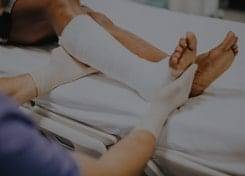Peripheral Arterial Disease
Peripheral Artery Disease (PAD) is a medical condition characterized by narrowing of the arteries in the legs, causing a reduction in circulation leading to pain in the toes, feet and legs. This can occur as a result of smoking, high cholesterol, diabetes or high blood pressure. The arteries can narrow or completely be blocked reducing the blood supply to the legs. The cramping symptoms are worse on exercising because the narrowed arteries cannot meet the muscles demand for oxygen. Left untreated, PAD can lead to amputation and put you or your loved one’s quality of life and long-term health at serious risk.
With an early diagnosis, you may have more treatment options and may have a better chance to reduce or eliminate your symptoms.

Varicose Veins
Varicose veins are often misunderstood as simply a cosmetic issue, but when left untreated, they can progress into a more serious condition called chronic venous insufficiency (CVI). You are not alone, nearly 25% of the global adult population is affected.
Healthy leg veins have valves that keep blood flowing to the heart. Vein disease develops when the valves stop working properly and allow blood to flow backward (i.e., reflux) and pool in the lower leg veins.

Spider Veins
Spider veins are small blood vessels in the most superficial layer of the skin (the dermis) that have become dilated and visible.
A genetic predisposition to the development of veins plays a role, as do the changes in hormones at puberty or pregnancy and the use of the birth control pill.
Sitting or standing for too long during the day appears to worse leg veins as well. Occasionally, veins may cause an aching sensation or pain.

Deep Venous Thrombosis (DVT)
Deep vein thrombosis, or DVT, is a large blood clot that forms in one or more of the deep veins in your body. DVT usually happens in the legs or pelvis, but a clot can form anywhere in your body. Sometimes, part of the blood clot can break off and travel to your lungs.

Hemarthrosis Embolization
Hemarthrosis is a medical condition in which there is bleeding into a joint cavity (heme = blood and arthrosis = joint). Hemarthrosis most commonly occurs in the knees, ankles, and elbows. However, it can also occur in other joints such as the wrists, shoulders, and hips.

Osteoarthritis Embolization
Osteoarthritis (OA) refers to the inflammation of joints (arthritis) along with wear and tear of the overlying cartilage. Cartilage, a type of connective tissue, provides a cushion in the joint allowing for frictionless movement. OA affects around 32.5 million adults in the United States every year. In most people, it presents as a chronic medical condition involving the joints in the knee, hands, elbow, and spine.1,2

